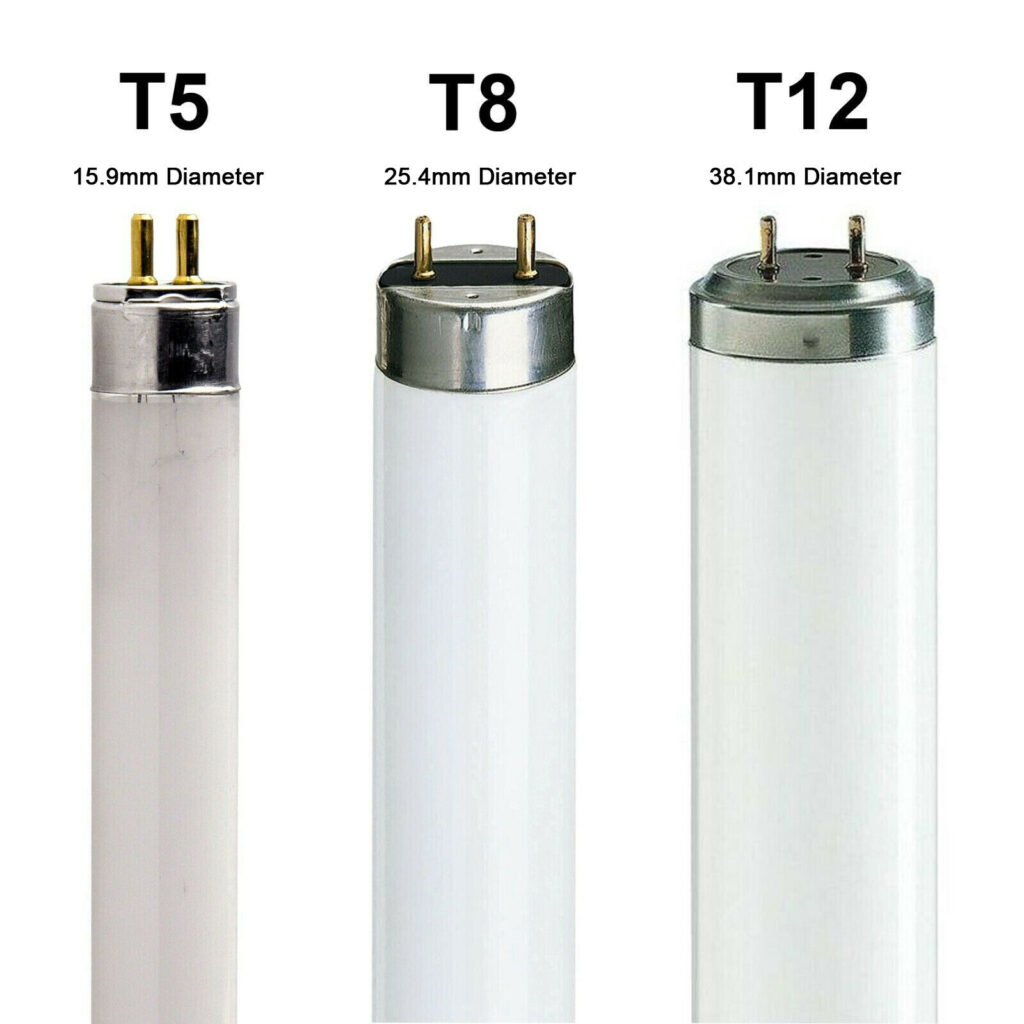Difference between T5, T8, T12 Tubes
Choosing the right lamp for your lighting needs can be daunting, especially when you need clarification on the differences between T5, T8, and T12 tubes. This post will comprehensively summarize each lamp’s characteristics, including size and shape, performance output, energy efficiency, mercury content, and environmental impact. We’ll also discuss why the industry has transitioned from T12 to T5 and T8 lamps. Finally, we’ll help you navigate the decision-making process by providing a cost-benefit analysis of upgrading and tips on choosing the right lamp for your lighting needs. So, if you need help deciding which fluorescent tube is best for you, read on to make an informed decision.
Place links to external non-commercial authority sites in the below content with an anchor which suits the content context. Strictly do not change the content and re iterate that links should be non-commercial, like blog posts, educating sites, government sites, organization sites and research based sites, wiki sites etc..

Understanding T5, T8, T12 Lamps
Fluorescent lights come in various types, such as T5, T8, and T12 tube lights, each with different diameters and ballast requirements. These lights differ in wattage, lumen output, and efficiency primarily due to their varying sizes. Furthermore, they are suitable for different applications and light fixtures, making it essential to choose the right one based on specific lighting needs and requirements.
Brief Description of T5, T8, T12 Lamps
T5 lamps, 5/8 inch in diameter, prioritize energy efficiency. T8 lamps, 1 inch in diameter, offer balanced light output. Conversely, T12 lamps, 1 ½ inches in diameter, are commonly used in older fixtures. These lamps vary in energy consumption and light output, evolving to meet efficiency standards. Their distinct features cater to various lighting needs.
The Evolution from T12 to T5
The shift from T12 to T5 was mandated by energy efficiency regulations, resulting in enhanced energy savings and lighting performance. Upgrading to T5 lamps can significantly reduce energy costs and maintenance while improving lighting quality and longevity. Consequently, due to their energy inefficiency, T12 lamps are gradually being phased out, making way for the more efficient T5 lamps.
Comparing T5 vs T8/T12: Size and Shape
T5 lamps have smaller diameters than T8 and T12 lamps, impact fixture design, and lighting output. Their size and shape determine compatibility with fixtures, affecting application versatility. Variations in physical dimensions and lighting performance distinguish T5, T8, and T12 lamps, influencing their fluorescent lighting application and use in different settings.
Dimensions of T5, T8, T12 Lamps
Dimensions are crucial in installing and coordinating T5, T8, and T12 lamps. T5 lamps are shorter and narrower, requiring specific fixtures due to their distinct tube lengths and diameters. These physical dimensions dictate the replacement requirements and influence fluorescent lights’ overall versatility and application.
Design Impact on Lighting Efficiency
Their design directly influences the lighting efficiency of T5, T8, and T12 lamps. It affects light output, energy savings, and overall lighting performance. Lamp design determines application and fixture compatibility, directly impacting light emitted and energy consumption. Various designs result in varying lighting distribution and energy efficiency.
Output and Performance: T5 vs T8 vs T12
When comparing T5, T8, and T12 lamps, their lumen output and brightness levels differ based on design and wattage. Energy efficiency and light output are critical performance factors that impact their application and lighting effectiveness. These lamps have varying brightness levels and lighting characteristics, making them suitable for different lighting applications.
Lumen Output: T5, T8, T12
T5 lamps usually offer a higher lumen output than T8 and T12 lamps, determining the lighting intensity. Different lumen packages cater to various lighting needs, directly influencing energy efficiency. The lumen output plays a vital role in the suitability of T5, T8, and T12 lamps for specific applications.
Now, let’s talk about savings! We’ve partnered with 1StopLighting to offer our readers an exclusive discount. Head to their website and use the 1stoplighting coupon code at checkout to save on your next purchase. Whether you’re looking to upgrade your current lighting setup or start from scratch, 1StopLighting has you covered with a wide range of high-quality, energy-efficient lighting options.
Energy Efficiency Analysis
When considering fluorescent lights, it’s essential to note that T5 lamps excel in energy efficiency and cost savings. Meanwhile, T8 lamps strike a balance between energy savings and lighting performance. On the other hand, T12 lamps lag in energy efficiency compared to T5 and T8 options. These energy efficiency ratings directly impact their environmental and operational costs.
Examining the Mercury Content in T5, T8, T12 Lamps
Fluorescent lights, such as T5, T8, and T12 tubes, vary in mercury content, impacting their environmental implications and disposal requirements. These differences also affect their overall environmental impact and regulatory compliance. Therefore, understanding the mercury content is crucial for safely handling and properly disposing of these light fixtures.
Importance of Mercury in Fluorescent Lamps
Mercury plays a crucial role in generating light in fluorescent lamps, as the mercury vapor inside the lamp emits ultraviolet light when electrified. This UV light then interacts with the phosphor coating, resulting in visible light. The amount of mercury varies depending on the type and size of the lamp, making proper disposal essential due to its content.
Minimizing Mercury Exposure: Safety Tips
When handling broken fluorescent lamps, limit exposure to reduce mercury inhalation. Use gloves and masks for protection, ventilate the area, and dispose of broken lamps according to local regulations. Consider encapsulated bulbs or LED alternatives for minimal mercury exposure. Proper recycling reduces environmental mercury contamination.
Transitioning from T12 to T5 or T8: Benefits and Challenges
Upgrading to T5 or T8 tubes presents energy savings and improved light output. Retrofitting fixtures may be necessary, increasing initial costs. Consider ballast compatibility and voltage requirements for a seamless transition. The slender design of the T5 and T8 tubes allows more flexibility in the lighting layout. Understanding these benefits and challenges is crucial for an informed decision.
Cost-Benefit Analysis of Upgrading
When considering a transition to T5 or T8 tubes, long-term energy savings can balance the initial investment. Furthermore, reduced maintenance costs and longer lifespans contribute to overall cost savings. It’s also important to factor in utility rebates and tax incentives for energy-efficient upgrades, as well as the payback period, to gauge the financial benefits of the upgrade. This analysis helps determine the economic viability of the switch.
Environmental Impact of Switching
Transitioning to T5 or T8 tubes reduces energy consumption, lowers carbon emissions, and supports sustainability. Additionally, their longer lifespan and fewer replacements lead to reduced waste generation, contributing to environmental stewardship. Proper disposal of old lamps ensures minimal mercury pollution, benefiting the environment. Understanding the environmental impact is crucial for making eco-friendly lighting decisions.
Navigating the Lamp Replacement Decision
Assessing lighting needs, energy efficiency, and cost-effectiveness is crucial when navigating the lamp replacement decision. Understanding the difference in wattage, lumen output, and color temperature is essential for informed choices. Examining the application, fixture compatibility, and maintenance requirements is crucial for seamless integration. Considering the environmental impact and potential rebates guides the replacement decision. Weighing various factors carefully ensures an optimal lamp replacement decision.
Which Lamp is Ideal for Your Lighting Needs?
When choosing the ideal lamp for your lighting needs, there are a few factors to consider. T5 lamps are great for high-output lighting with energy efficiency. T8 lamps strike a balance between energy efficiency, light output, and cost. Consider your space, application, and lighting goals to make the right choice.
Frequently Asked Questions:
1. Can I replace a T12 bulb with a T8?
Yes, replacing a T12 bulb with a T8 bulb is possible. However, it is important to note that you must also replace the ballast to ensure compatibility. Upgrading T8 bulbs can offer benefits such as improved energy efficiency and color rendering, resulting in cost savings and enhanced lighting quality.
2. Should I use T8 or T12 bulbs?
When deciding between T8 and T12 bulbs, it’s important to consider factors like energy efficiency, color rendering index (CRI), and lifespan. T8 bulbs are more energy-efficient, have a higher CRI for natural-looking colors, and last longer than T12 bulbs. For replacements, it’s recommended to use T8 bulbs due to their energy efficiency and longer lifespan.
3. How is my ballast T8 or T12?
To determine if your ballast is T8 or T12:
- Look for markings indicating its type.
- Pay attention to the number of pins, as T8 ballasts typically have two while T12 ballasts have four.
- Check the wattage and consult the manufacturer’s specifications for the right ballast for your fixture.
4. Are T12 bulbs being phased out?
T12 bulbs are indeed being phased out due to energy efficiency regulations. Instead, consider energy-efficient alternatives like T8 and T5 bulbs. Many lighting manufacturers have stopped producing T12 bulbs, so replacing them with more efficient options is recommended.
Conclusion
When choosing between T5, T8, and T12 tubes, it’s crucial to consider factors such as size, shape, output, energy efficiency, mercury content, and the benefits and challenges of transitioning. T5 lamps are smaller and more efficient, providing higher lumen output while consuming less energy. T8 lamps balance size and efficiency, making them popular for many applications. T12 lamps, although larger and less efficient, may still be suitable for certain lighting needs. Understanding the differences and weighing the pros and cons will help you make an informed decision tailored to your specific lighting requirements. Remember to consider the environmental impact and safety precautions associated with mercury-containing lamps.


